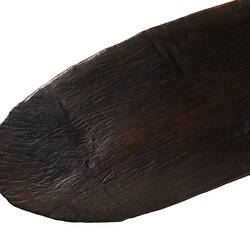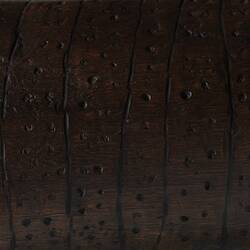Summary
To learn fighting and hunting skills, the father and uncles of a young boy made small weapons for him. These child-sized weapons and tools were skilfully made and decorated in the same manner as the adult ones. This small mulga (shield) has been carved from a single piece of wood and has been decorated with an engraved design and coated with oil.
Smaller versions of the weapons and implements used by adults were important teaching tools to ensure children developed the skills they would need in later life. Young boys practised with their small weapons and tools from an early age, imitating the adults, playing games with each other and hunting small animals. They would also use the resources available to them and make their own toy weapons when playing.
The exact provenance of this mulga, the name of its maker and his cultural group is unknown due to the highly problematic collection practices of colonial times which showed widespread ignorance of the diversity and specificity of Aboriginal culture and peoples.
Local Name
Mulga
Physical Description
Small oblong shaped shield used as a toy when training young people about hunting and fighting. Handle carved from the solid. Posterior surface is flat, anterior surface curved and incised with a dot and line pattern that is repeated from end to end. Shield has been stained.
Significance
A skilled craftsman made this small mulga to fit into the small hand of a young child, for him to play with it and consequently learn the uses of these important tools and the significant skills required to use them.
In his 1878 publication 'The Aborigines of Victoria', civil servant and armchair anthropologist Robert Brough Smyth recorded;
'The toy weapons which are made for the use and amusement of the children. The care that is taken in teaching the boys to throw the spear, to use the stone tomahawk, the shield and the club; the instruction that is given them in climbing trees, using the net and in digging for the wombat, make them even when young quite accomplished bushmen' Robert Brough Smyth,1878.
Respected Narrindjerri/Yorta Yorta/Wathuarong Elder Uncle David Tournier speaks of the importance in Aboriginal culture of teaching and nurturing children and young people;
'After doing all of my primary schooling and a year and a half of secondary school in Geelong we then moved to Swan Hill where I was taught a lot about my culture, from my Uncles and Aunties, how to hunt and gather, how to track, the use of various plants etc.
I just love sitting and talking with my family when we get the time. In their younger days we spent a lot of time out bush, where I would teach them the things that I was taught. I always instilled in my children the importance of Education and how it can influence your life no matter what sort of job it may be.'
Uncle David Tournier, 2016
More Information
-
Object/Medium
Shield
-
Maker
-
Locality
-
Date Produced
-
Collector
-
Object Measurements
470 mm (Length), 100 mm (Width), 35 mm (Height)
-
Classification
-
Date Made
-
Maker
-
Clan/Language Group
-
Place Made
-
Indigenous Region
-
Keywords
-
Collection Names
-
Type of item
-
Discipline
-
Category
-
Collecting Areas







